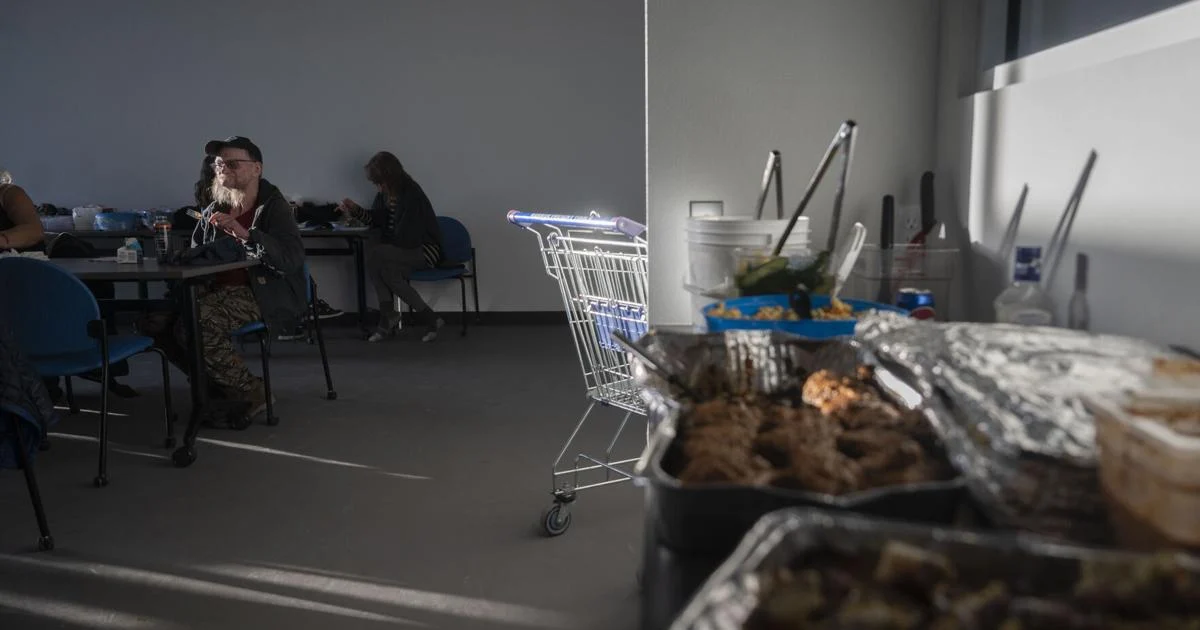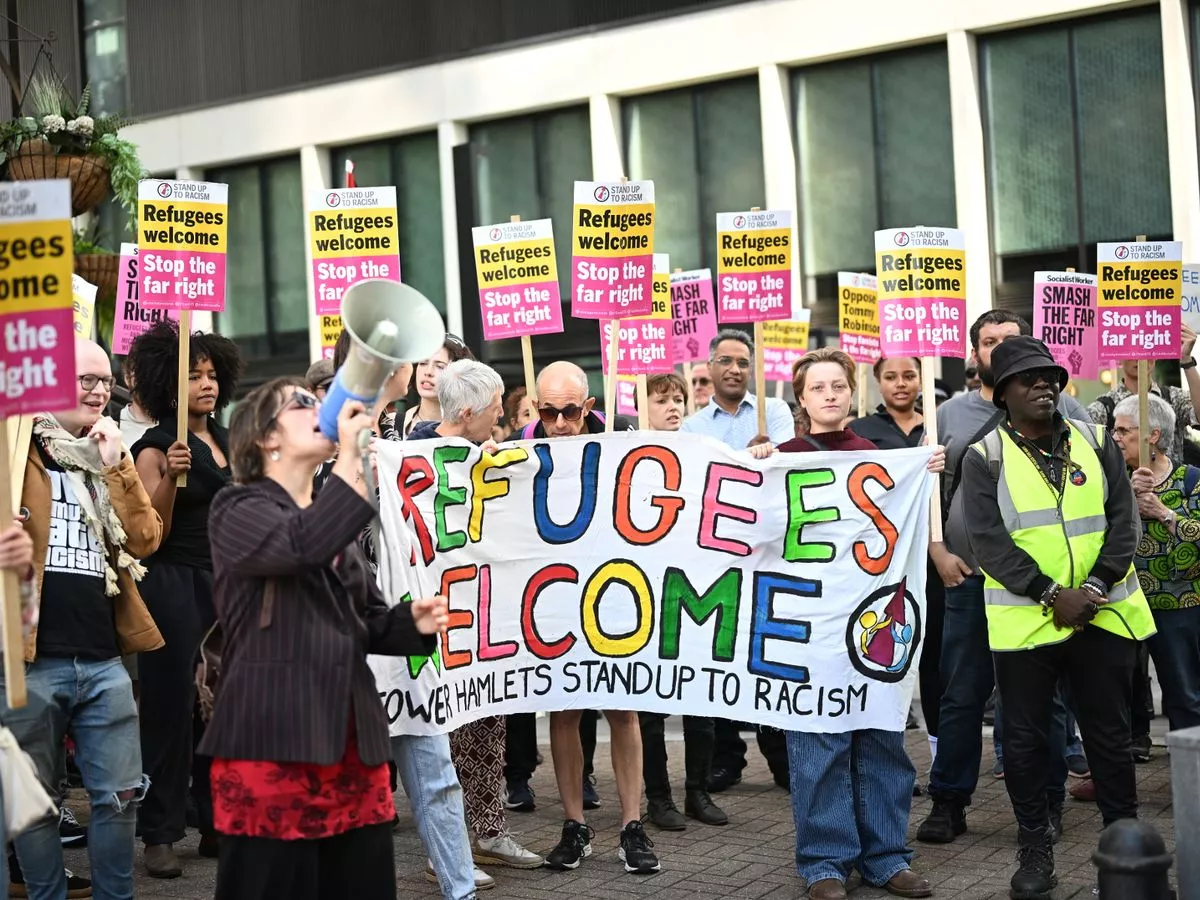
When Tonya Ridesatthedoor arrived in Missoula about four months ago to start fresh after serving time in prison, she was homeless and needed “anything and everything.”
Ridesatthedoor told Montana Free Press she was “institutionalized” and unsure where to turn for help.
An effort to relocate Johnson Street Shelter guests successfully placed 55 people into permanent housing as the 165-bed facility closed its doors this week following a strategic wind-down.
“It was so easy for me in my head to be overwhelmed,” she said.
Shortly after moving from the Johnson Street homeless shelter in Missoula to a pallet home as part of a transitional housing program, Ridesatthedoor learned about the Watershed Navigation Center.
“I kept coming back,” she said. “I felt so welcome, supported and safe. … I know even if I show up in tears, they will help.”
The Watershed Navigation Center was built next to the Missoula County jail as part of the Trinity Apartments affordable housing project, which opened in 2023. The navigation center opened full-time in mid-September after operating part-time for the last several months. Part of its mission is to connect unhoused people or those recently incarcerated to resources that could help curb recidivism.
“Our hope with being able to get people at the point of reentry or being housing insecure and hooking them into community-based services is we keep people out of jail and keep people in the communities they live in,” said Chelsea Wittmann, the county’s justice initiatives coordinator.
Staff at Watershed, which includes a Partnership Health Center clinic and Missoula County’s reentry program, helped Ridesatthedoor establish primary care at the clinic and get work through the staffing agency PeopleReady. With help from Watershed, Ridesatthedoor moved into an apartment in early September, the first time she’s secured housing on her own, she said.
“There’s no judgment at all,” Ridesatthedoor said. “Just 110%, 120% support in whatever you’re aiming for in life.”
About 10 years ago, former Missoula County Sheriff T.J. McDermott commissioned a plan to address chronic jail overcrowding. The plan concluded that the detention center would have to be expanded if the county did not implement “significant diversionary efforts in the near future.”
At the time, reentry services at the jail were limited, “and for most, non-existent,” according to the plan. Wittmann said people were handed a list of resources on their way out the door.
“We’re looking forward to Watershed being sort of that missing piece as a resource hub and a way for people who are experts in their field to continue doing their jobs, helping people through the appropriate stages and not having to hash out those community connections themselves,” she said.
In 2019, the Missoula County commissioners donated four acres adjacent to the jail to the Missoula Housing Authority and Homeword for the 202-unit Trinity Apartments project, with the intention that the land would be used for low-income and supportive housing, as well as a navigation center.
The county kept enough land around the jail to add more cells if necessary, but the commissioners saw a long-term benefit of people receiving community-based services rather than spending more time incarcerated, said Chris Lounsbury, the county’s chief administrative officer.
Several new or expanded behavioral health and court programs have helped divert people from the jail, according to the 2022 update to the 2016 plan. The jail now holds fewer nonviolent offenders, but an increase in the number of inmates requiring a single cell due to mental health problems in recent years has strained capacity and increased costs, officials told MTFP earlier this year.
A report released earlier this year linking homelessness and criminal justice involvement noted resources like Watershed show promise, but gaps remain. The study found unhoused people in Missoula were disproportionately involved in the justice system, accounting for 18% of jail bookings in 2023; many were booked for low-level charges. Native Americans made up 2% of Missoula’s population but 15% of unhoused people, according to the report. About 25% of unhoused people booked into jail were Native American.
Watershed could be a space to provide services for those who are disproportionately represented, “so we can start turning the needle on some of these more vulnerable populations and their justice involvement and housing insecurity,” said Karissa Trujillo, Homeword’s executive director.
“I’m proud that we’ve been able to create a space that is already being utilized and making an impact,” she said. “I can see that growing as word spreads and as clients find success.”
While the Watershed Navigation Center and its clinic target certain populations, it is open to anyone, Trujillo said.
Like other Partnership Health Center clinics, the Watershed site serves all patients, regardless of their ability to pay, and accepts Medicaid and private insurance. The clinic offers medical, dental and behavioral health services, and PHC’s community care team helps people find housing and connect with other resources.
Chaz Rourke, the Watershed manager, said the space provided the next step in following PHC’s street medicine team, which began in 2022 to offer medical services and other support to unsheltered people.
“There’s a limit to what you can provide for someone outside their tent,” he said. “Here you can meet someone where it’s safe and warm. People are getting housed and feeling safe and seen.”
Missoula County’s reentry navigator, Ty Robinson, began working at Watershed in May, helping individuals exiting jail or the Montana State Hospital “get their bearings,” access resources and reintegrate into the community, he said. The county reentry program is funded by a state grant through June 2027.
Robinson coordinates with the jail’s medical provider to help people continue their medication or treatment started while they are incarcerated, upon their release. Robinson said he receives about four referrals per week from the jail, courts and pretrial programs and also works with people who walk into the center.
The biggest need and challenge is housing, with limited options for people with a criminal record, Robinson said. For motivated people like Ridesatthedoor, one of the first clients Robinson worked with, finding housing can still take months in part because of lengthy waiting lists for federal vouchers or affordable units, he said.
But timelines vary, and people are getting housed, Rourke said.
Sixto Cordova got a job and was on the verge of securing housing for himself and his sister about a week after he started visiting Watershed. Cordova told MTFP he lived in Great Falls for 19 years before traveling to Texas with his sister to visit a dying friend. They then moved to Missoula to find a place to settle down, he said.
After staying at the Poverello Center, Cordova visited Watershed in search of a locker. He connected with PeopleReady and got a job the next day.
“If it wasn’t for this place, I wouldn’t have found that opportunity,” Cordova said.
Cordova said he was able to submit information to the Missoula Housing Authority at Watershed, avoiding a trip across town.
“If you really need a place to come and people that will help you, come here,” he said.
Cordova and his sister stopped by Watershed Sept. 10 to hang out and charge their phone before touring a house that evening. The two were among several familiar and new faces at Watershed that afternoon, a typically busy time at the center, Robinson said.
About six or seven people sat in chairs or on couches in the community room watching TV, charging their phones, eating snacks or talking with staff and each other. One woman perused the racks of free clothes while another checked the laundry schedule. Rourke said the laundry and locker room is probably the most used area of Watershed.
Near the front desk, where a staff member is ready to answer questions or distribute food or hygiene kits, computers and a printer are available for use.
While staff often meet with clients in the community room, offices are available, including for county and city pretrial programs. Rourke said engaging with community partners is a key piece of Watershed.
Missoula Municipal Court began holding Community Court, which brings court services to those unhoused or staying in a shelter, at Watershed last month. Stephen Thompson, the court programs administrator, told MTFP in early September that Watershed offered an ideal location because it is adjacent to the jail and already serves as a resource hub.
“People already want to go there,” he said. “Trying to increase the number of resources … people are looking for is our way of trying to increase that incentive for attending court.”
In mid-September, Missoula Interfaith Collaborative’s Housing Advocate Network began holding drop-in hours twice a week at Watershed to support people searching for housing. Zeke Campfield, the network’s director, said the center is accessible, welcoming and with other services on site, it is becoming a “natural magnet” for people.
However, Watershed can be a “vibrant place full of people,” making quiet connections and often vulnerable conversations challenging, Campfield said. The organization will adjust as needed and is seeking additional volunteers, he said.
“We’re still feeling out the space and the logistics for how things run, but the purpose and intention [of HAN] is being enlivened in that space,” Campfield said. “It’s a place that anybody is welcome to stop in, … and there’s somebody there to listen to them, support them, maybe direct them to resources or provide some in-the-moment support.”
Watershed provided a stable meeting place for Welcome Back, a community support group for people exiting incarceration, when it restarted meetings in April after more than a year break, said Ali Lacayo, the group’s operations coordinator and senior community organizer.
“What we want to do is give someone community, give them a safe place where you’re not seen as your crime, you’re seen as someone that wants to do better and be better and be a better community member,” Lacayo said.
Meeting in a space where other services are offered helps strengthen Welcome Back’s ability to help members connect with housing, employment or mental health care, Lacayo said.
“That’s what I like about being there at the Watershed; it allows us to be more connected,” they said. “And then we’re right next door to the county jail if someone discharges from prison. I’ve seen a lot of times where they get discharged and they’re like, ‘I have nowhere to go. I’m homeless.’ And so the goal is to be in a position where we can help them with services.”
Still, more work is needed to humanize people exiting incarceration and address community-wide challenges such as housing availability and affordability, Lacayo said.
While more help is available than when Lacayo was released from prison in 2019, living in Missoula has become more difficult for returning citizens due to the city’s camping regulations, the closure of the Johnson Street homeless shelter and a lack of housing, they said.
Robinson, the reentry navigator, said he expects Watershed to become busier with its expanded hours, the shelter closure, and the approaching colder weather.
“I would like folks to know that Watershed is here to help,” he said.
Cordova and Ridesatthedoor said they’ll keep coming back to share their experiences.
“I will be here a lot because these people are my family,” Ridesatthedoor said.
You must be logged in to react.
Click any reaction to login.
Love
0
Funny
0
Wow
0
Sad
0
Angry
0
Get Government & Politics updates in your inbox!
Stay up-to-date on the latest in local and national government and political topics with our newsletter.
* I understand and agree that registration on or use of this site constitutes agreement to its user agreement and privacy policy.



